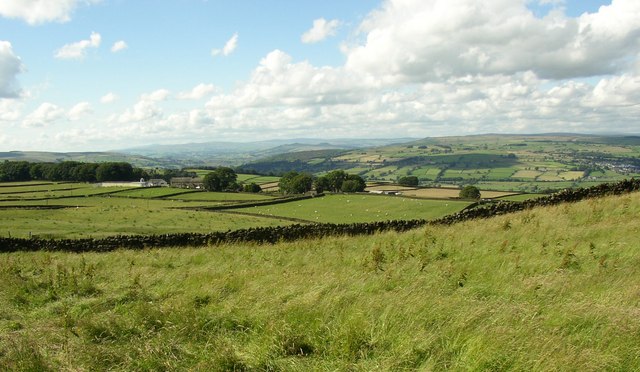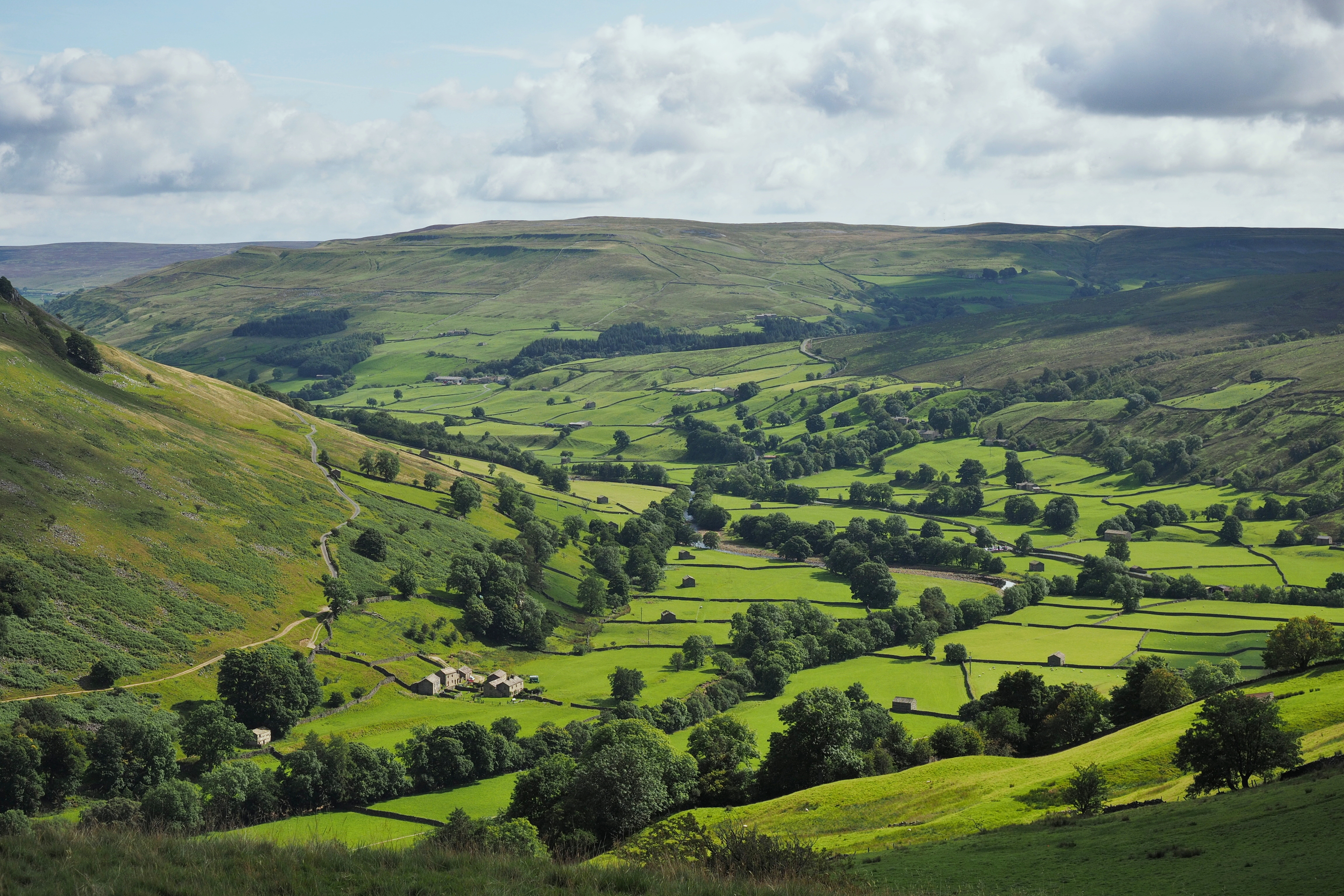|
Airedale
Airedale is a valley, or Dale (landform), dale, in North Yorkshire and West Yorkshire, England. It is named after the River Aire, which flows through it. The upper valley, from Malham Cove to Airton, is known as Malhamdale, named after the village of Malham. At Airton the valley widens and becomes Airedale proper. The river flows past Skipton on to Keighley, Bingley, Shipley, West Yorkshire, Shipley, and Leeds. Airedale, in conjunction with the Ribble Valley, provides low-altitude passes from Yorkshire to Lancashire through the Aire Gap. It is therefore an important transport route and was a strategically important area historically. History The upper Aire valley was formed 12,000 years ago by a retreating glacier. A moraine formed in the Cononley area and the lake stretched as far north as Gargrave. Colonisation by man developed later on, especially during the Iron Age. The peoples that occupied the Aire Valley (and much of north eastern England) were called Brigantes by t ... [...More Info...] [...Related Items...] OR: [Wikipedia] [Google] [Baidu] [Amazon] |
Worth Valley (dale)
The Worth Valley is a geographic area in West Yorkshire, England, that extends eastwards from Crow Hill and Oxenhope Moor, providing drainage for the River Worth for nearly to the River Aire. It is a side valley to Airedale, with the River Worth being a major tributary of the River Aire. The Worth Valley was important for its contribution to the textiles industry of the West Riding of Yorkshire and was furnished with several reservoirs to allow mills to operate within the valley. Most of the reservoirs are still in use into the modern day. The valley has seen a shift in its industry from worsted, wool, and before that mining and quarrying, into a tourist location. The association with the Brontë family, and the Keighley and Worth Valley Railway, has drawn many visitors to the area, particularly from Japan. Connected with these attractions has been the film and TV industry which have recorded shots, programmes, and entire films in the area. History In the period when Airedale w ... [...More Info...] [...Related Items...] OR: [Wikipedia] [Google] [Baidu] [Amazon] |
Keighley
Keighley ( ) is a market town and a civil parishes in England, civil parish in the City of Bradford Borough of West Yorkshire, England. It is the second-largest settlement in the borough, after Bradford. Keighley is north-west of Bradford, north-west of Bingley, north of Halifax, West Yorkshire, Halifax and south-east of Skipton. It is governed by Keighley Town Council and Bradford City Council. Keighley is in West Yorkshire, close to the borders of North Yorkshire and Lancashire. Historic counties of England, Historically in the West Riding of Yorkshire, it lies between Airedale and Keighley Moors. At the 2011 census, Keighley had a population of 56,348. History Toponymy The name Keighley, which has gone through many changes of spelling throughout its history, means "Cyhha's farm or clearing", and was mentioned in the Domesday Book of 1086: "In Cichhelai, Ulchel, and Thole, and Ravensuar, and William had six carucates to be taxed." Town charter Henry de Keighley, a ... [...More Info...] [...Related Items...] OR: [Wikipedia] [Google] [Baidu] [Amazon] |
River Aire
The River Aire is a major river in Yorkshire, England, in length. Part of the river below Leeds is canalised, and is known as the Aire and Calder Navigation. The ''Handbook for Leeds and Airedale'' (1890) notes that the distance from Malham to Howden is direct, but the river's meanderings extend that to . Between Malham Tarn and Airmyn, the river drops . Course The Aire starts at Malham Tarn and becomes a subterranean stream at 'Water Sinks' about one mile (1.6 km) before the top of Malham Cove, it then flows underground to Aire Head, just below Malham, in North Yorkshire, and then flows through Gargrave and Skipton. After Cononley, the river enters West Yorkshire where it passes through the former industrial areas of Keighley, Bingley, Saltaire and Shipley. It then passes through Leeds and on to Swillington and Woodlesford. At Castleford is the confluence of the Aire and Calder; just downstream of the confluence was the ford where the ancient British road, us ... [...More Info...] [...Related Items...] OR: [Wikipedia] [Google] [Baidu] [Amazon] |
Cononley
Cononley ( or ) is a village and civil parish in the county of North Yorkshire, England. Cononley is in the Airedale, Aire Valley south of Skipton and with an estimated population of 1,080 (2001 est.), measured at 1,172 at the United Kingdom Census 2011, 2011 census. It is situated west of the A629 road with access to Skipton, Keighley. Also joined to the Leeds-Carlisle railway, the village has commuter access to Leeds and Bradford. Until 1974 it was part of the West Riding of Yorkshire. From 1974 to 2023 it was part of the district of Craven District, Craven, it is now administered by the unitary North Yorkshire Council. The village is served by Cononley railway station. History and information The origin of the settlement There is evidence that people first settled around Cononley in the Bronze and Iron Ages. The Domesday Book contains only a brief mention of Cononley, but the settlement's name had probably originated several centuries earlier. The ending 'ley' refer ... [...More Info...] [...Related Items...] OR: [Wikipedia] [Google] [Baidu] [Amazon] |
Aire Gap
Aire Gap is a pass through the Pennines in England formed by geologic fault (geology), faults and carved out by glaciers. The term is used to describe a geological division, a travel route, or a location that is an entry into the Aire river valley. Geology Geologically the Aire Gap lies between the Craven Fault and the limestone uplands of the Yorkshire Dales to the north and the Forest of Bowland and the millstone grit moors of the South Pennines. The South Pennines is the system between the Aire Gap and the Peak District.Encyclopædia Britannica The gap was formed by the dropping of the Craven Faults in the Carboniferous through Jurassic periods combined with glacial scouring by ice sheets in the Pleistocene Ice Age. The Aire Gap splits the Pennines into north and south by allying with the River Ribble. The Pennine chain is divided into two sections by the Aire Gap formed by the River Aire flowing south, a member of the Humber basin, and the Ribble flowing west and entering th ... [...More Info...] [...Related Items...] OR: [Wikipedia] [Google] [Baidu] [Amazon] |
Yorkshire Dales
The Yorkshire Dales are a series of valleys, or Dale (landform), dales, in the Pennines, an Highland, upland range in England. They are mostly located in the Ceremonial counties of England, ceremonial county of North Yorkshire, but extend into Cumbria and Lancashire; they are entirely within the Historic counties of England, historic boundaries of Yorkshire. The majority of the dales are within the Yorkshire Dales National Park, created in 1954. The exception is the area around Nidderdale, which forms the separate Nidderdale AONB, Nidderdale Area of Outstanding Natural Beauty. The landscape of the Yorkshire Dales consists of sheltered glacial valleys separated by exposed moorland. The predominant rock is Carboniferous Limestone, which is particularly visible in the south-west in features such as Malham Cove. It is overlain in many areas by the Yoredale Series of alternating weak shales and hard limestones and sandstones, which give the dales their characteristic 'stepped' appeara ... [...More Info...] [...Related Items...] OR: [Wikipedia] [Google] [Baidu] [Amazon] |
Shipley, West Yorkshire
Shipley is a historic market town and civil parish in the City of Bradford, West Yorkshire, England. Located on the River Aire and the Leeds and Liverpool Canal, Shipley is directly north of the city of Bradford. The population of Shipley at the 2011 Census was 15,483. Until 1974, Shipley was an Urban district (Great Britain and Ireland), urban district in the West Riding of Yorkshire. The town forms a continuous urban area with Bradford. History Toponymy The toponymy, place-name ''Shipley'' derives from two words: the Old English ('sheep', a Northumbrian dialect form, contrasting with the Anglian dialects#Dialects, Anglian dialect form which underlies modern English ''sheep'') and meaning either 'a forest, wood, glade, clearing' or, later, 'a pasture, meadow'. It has therefore been variously defined as 'forest clearing used for sheep' or 'sheep field'. Early history Shipley appears to have first been settled in the late Bronze Age and is mentioned in the ''Domesday ... [...More Info...] [...Related Items...] OR: [Wikipedia] [Google] [Baidu] [Amazon] |
Bingley
Bingley is a market town and civil parish in the metropolitan borough of the City of Bradford, West Yorkshire, England. It is sited on the River Aire and the Leeds and Liverpool Canal. The town had a population of 18,040 at the United Kingdom 2021 Census, 2021 Census. History In 1775, a farmer near Bingley discovered a chest of silver coins, of which some dated to the rule of Julius Caesar, on his land. Founding Bingley was likely founded by the Saxon people, Saxons, by a ford on the River Aire. This crossing gave access to Harden, West Yorkshire, Harden, Cullingworth and Wilsden on the southern side of the river. The origins of the name are from the Old English personal name ''Bynna'' + ''ingas'' ("descendants of") + ''lēah'' ("clearing in a forest"). Altogether, this would mean the "wood or clearing of the Bynningas, the people called after Bynna". Normans In the Domesday Book of 1086, Bingley is listed as "Bingheleia": ''m In Bingheleia hb. Gospatric iiij car' tra e' a ... [...More Info...] [...Related Items...] OR: [Wikipedia] [Google] [Baidu] [Amazon] |
Leeds
Leeds is a city in West Yorkshire, England. It is the largest settlement in Yorkshire and the administrative centre of the City of Leeds Metropolitan Borough, which is the second most populous district in the United Kingdom. It is built around the River Aire and is in the eastern foothills of the Pennines. The city was a small manorial borough in the 13th century and a market town in the 16th century. It expanded by becoming a major production and trading centre (mainly with wool) in the 17th and 18th centuries. Leeds developed as a mill town during the Industrial Revolution alongside other surrounding villages and towns in the West Riding of Yorkshire. It was also known for its flax industry, iron foundries, engineering and printing, as well as shopping, with several surviving Victorian era arcades, such as Kirkgate Market. City status was awarded in 1893, and a populous urban centre formed in the following century which absorbed surrounding villages and overtook t ... [...More Info...] [...Related Items...] OR: [Wikipedia] [Google] [Baidu] [Amazon] |
Dale (landform)
A dale is a valley, especially an open, gently-sloping ground between low hills with a stream flowing through it. It is used most frequently in Northern England, the North of England and the Southern Uplands of Scotland; the term "fell" commonly refers to mountains or hills that flank a dale. As with many other words, ''dale'' was preserved by Danelaw, Viking influence in Northern England. It appears in various contexts, such as wikt:up_hill_and_down_dale, up hill and down dale "over every hill and dale", and "up all hills, down all dales. Etymology The word ''dale'' comes from the Old English word ''dæl'', from which the word "dell (landform), dell" also derived. It is related to Old Norse word ''dalr'' (and the modern Icelandic language, Icelandic word ''dalur'', etc.), which may have influenced its survival in northern England. The Germanic origin is assumed to be *''dala-''. ''Dal-'' in various combinations is common in placenames in Norway. Modern English valley and Frenc ... [...More Info...] [...Related Items...] OR: [Wikipedia] [Google] [Baidu] [Amazon] |
Saltaire
Saltaire is a Victorian model village near Shipley, West Yorkshire, England, situated between the River Aire, the railway, and the Leeds and Liverpool Canal. Salts Mill and the houses were built by Titus Salt between 1851 and 1871 to allow his workers to live in better conditions than the slums of Bradford. The mill ceased production in 1986, and was converted into a multifunctional location with an art gallery, restaurants, and the headquarters of a technology company. It is a UNESCO World Heritage Site and on the European Route of Industrial Heritage. History Saltaire was commissioned in 1851 by Sir Titus Salt, a leading industrialist in the Yorkshire woollen industry. The name of the village is a combination of the founder's surname and the name of the river. Salt moved his business (five separate mills) from Bradford to this site near Shipley to arrange his workers and to site his large textile mill by the Leeds and Liverpool Canal and the railway. Salt employed t ... [...More Info...] [...Related Items...] OR: [Wikipedia] [Google] [Baidu] [Amazon] |
Skipton
Skipton (also known as Skipton-in-Craven) is a market town and civil parish in North Yorkshire, England. Historically in the East Division of Staincliffe Wapentake in the West Riding of Yorkshire, it is on the River Aire and the Leeds and Liverpool Canal to the south of the Yorkshire Dales. It is situated north-west of Leeds and west of York. At the 2021 Census, the population was 15,042. The town has been listed as one of the best and happiest places to live in the UK. History Evidence for prehistoric habitation in the Skipton area includes an "important outlying group" of cup and ring marked rocks on Skipton Moor, to the south-east of the town, and in the same area there is an enclosed Iron Age hilltop settlement. The name Skipton means 'sheep-town', a northern dialect form of ''Shipton''. Its name derives from the Old English ''sceap'' (sheep) and ''tun'' (town or village). The name is recorded in the Domesday Book of 1086. The town was important during the E ... [...More Info...] [...Related Items...] OR: [Wikipedia] [Google] [Baidu] [Amazon] |










